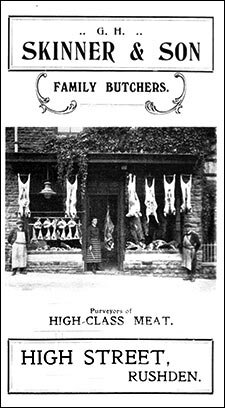|
|
||||||||||||||||||||
|
Messrs. Skinner - Butchers
|
||||||||||||||||||||
|
||||||||||||||||||||
|
||||||||||||||||||||
|
George Skinner (born 17th April 1817) and his two brothers, Eli (born 1815) and Henry (born 1819), were all baptised in Rushden on 18th April 1824, as sons of William (farmer) & Sarah. William had died and was buried, aged 42, at St Mary's Church on 14th April 1820. Sarah remarried in October the following year, to Thomas Brawn.
As a young man, George went to Bedford and set up a business as a butcher there. He married Hannah Banks (born Hail Weston) in 1839, and their first child Ann was born in 1840 in Bedford. They moved to Rushden and their son George Henry was born in 1842 (and baptised in October 1843), and his twin brothers, Robert (died aged 3) and Morris in 1844, and William Banks was born in 1849. On 23rd September 1849 George and Morris were baptised again with their new baby brother, and George was well established as a butcher. In 1859 his wife Hannah died, and in 1861 George was farming 50 acres of land, and he was a churchwarden at St. Mary's Church. In 1869 George married again, to Jane Harris from Alconbury, HUN, and the family were now farming 400 acres, on the Home Farm of Rushden Hall Estate, and the butcher's shop. Two years later, his son William Banks Skinner married Jane Lilley at Rushden. William was a commercial traveller in the drapery trade, and then in leather trade, and in 1881 he went into partnership with Thomas Lilley, and the company was renamed Messrs Lilley and Skinner. Skinner's farm was opposite The Green, at the junction of Wellingborough Road and High Street South. They had their own slaughterhouse and sold the meat from a shop in the farmhouse, at the top of the hill, named after the family as "Skinner's Hill", and the shop faced the Church. George senior was a well respected member of the church and served as churchwarden for over 50 years. He was also an overseer of the poor, and was a familiar sight around the town riding a tricycle, and he had lived to become the oldest inhabitant in Rushden when he died in 1914, aged 97 years. Son George Henry had taken over the butchery business in 1865, whilst George senior concentrated on the farming. He and Jane retired about 1885, when they left the businesses in the hands of his sons, and moved to 13 Park-road, close to son Morris. About 1895, George junior opened a second shop at 196 Wellingborough Road, where his son, William H Skinner, born 1871, was in charge. During WWI his father was ill, and William moved back to the High Street shop, and his shop was taken over by Frederick Collins, as a grocery shop to trade alongside his dairy business at 182 Wellingborough Road. George Henry died in 1918.
|
||||||||||||||||||||
|
Former employee Pte Charles Norman Another obituary |
||||||||||||||||||||








